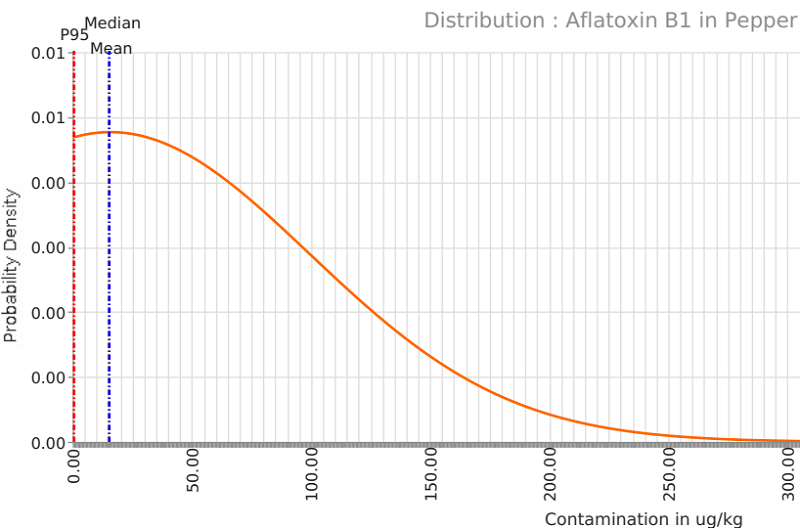Aflatoxin B1 (AFB1) is a toxin produced by mold (Aspergillus flavus and A. parasiticus) in the food products. It is one of the most potent carcinogen. Based on WHO/FAO data, the distribution of Aflatoxin B1 in different category of food products is shown in the figure below.

The major categories of food products likely to have AFB1 contamination are: (1) Nuts and Oilseeds; (2) Herbs, spices and condiments; and (3) Cereals and cereal-based products.
1. Nuts and Oilseeds: AFB1 is generally found to be contaminated in hazelnut, pistachio nut, almond and peanut. The probability distribution of concentration of AFB1 (mcg/kg) in these nuts are shown in the figure below.




(2) Herbs, spices and condiments: Spices are another major source of AFB1 exposure. AFB1 is commonly contaminated in the the dried spices such as nutmeg, pepper, chilies etc. These spices are one of our daily food ingredients.



(3) Cereals and Cereal based products: The probability distribution of AFB1 concentration (mcg/kg) in maize, rice and other cereal products are shown in the figures below.




Rice is a staple food in South East Asia. Rice is less likely to get AFB1 contamination in comparison to maize and other cereal products, however, significant quantities of AFB1 has been detected in rice as well. Because of high consumption of rice (200 to 400 g/person/ day), even the contamination of 5 mcg/kg will result in the exposure of around 17 ng/kg BW/day. If we compare with the BMDL10 value of 170 ng/kg BW/day , the margin of exposure (MOE) will only be around 10 (ten). EFSA (European Food Safety Authority) recommends to have MOE of more than 10,000 for such genotoxic compounds. The recent studies have found the evidences of presence of AFB1- lysine adduct in the blood of pregnant women of Nepal consuming rice dominated diet. This could clearly be an indicator of the high dietary exposure of AFB1 in the Nepalese population.
We need to think more about the current food control system of Nepal.We should start asking questions ourselves: Have we carried out the risk assessment? Is the mandatory standard scientific enough to provide protection to general population? Do we have enough surveillance and monitoring program for AFB1? Do we have appropriate risk management and risk communication activities to mitigate AFB1 problem? We should not wait for Aflatoxin outbreaks like in Tanzania to happen in Nepal. Let's hope that Nepalese government will take appropriate action to mitigate the problem soon.
Please, feel free to provide your valuable suggestions.






No comments:
Post a Comment